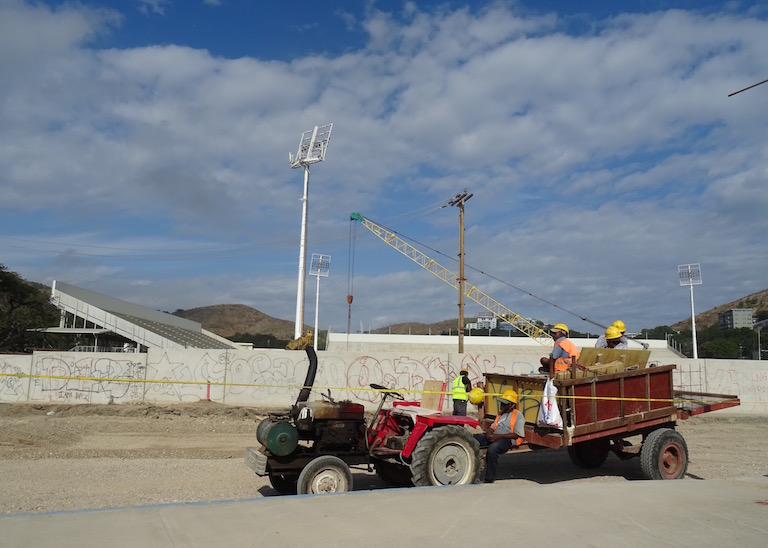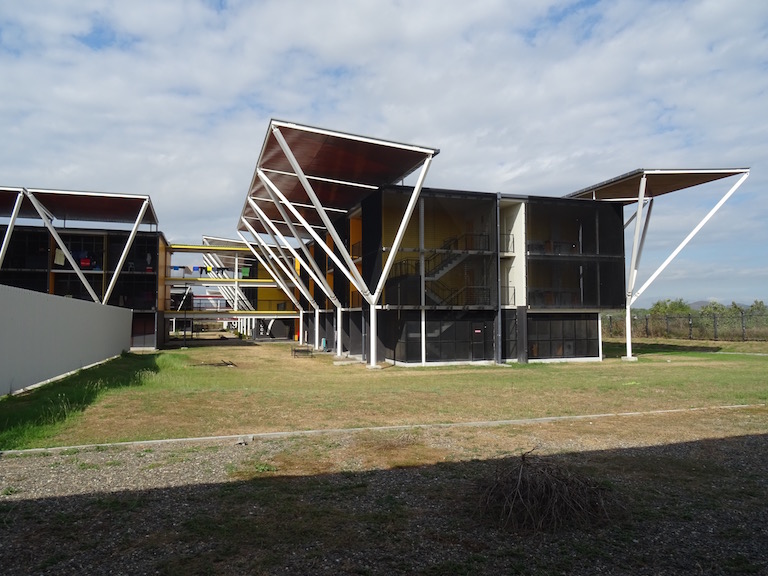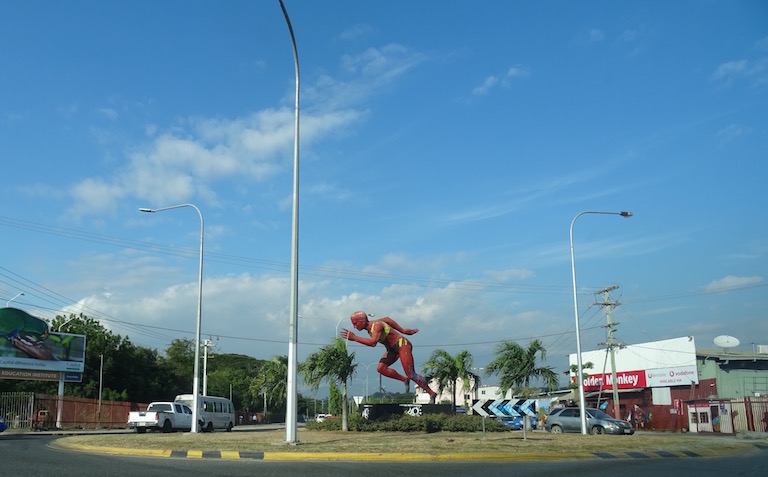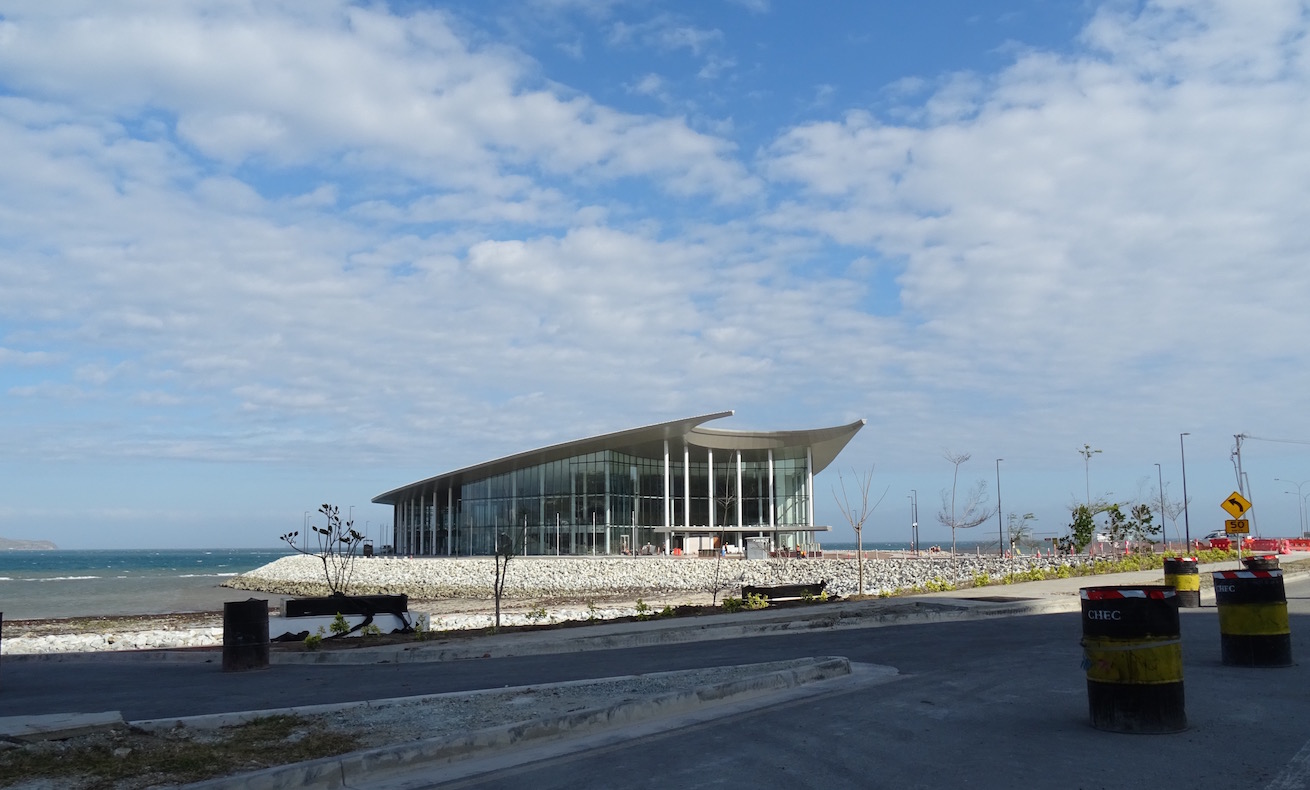- Papua New Guinea will host the 2018 Asia-Pacific Economic Cooperation (APEC) Summit this week.
- The PNG government says the summit will catalyze economic growth and development, but opposition leaders have criticized what they say is extravagant spending even as infrastructure and public services remain severely underfunded.
- The experience of the 2015 Pacific Games, the last time PNG hosted a major international event, could hint at the long-term legacy the APEC summit will leave behind.
The Asia Pacific Economic Cooperation (APEC) Summit that opens in Port Moresby this week is supposed to be a showcase of Papua New Guinea’s hosting, but the run-up to the event has been overshadowed by fast cars.
Italian-made Maseratis, mostly — 40 of them, flown in on specially chartered cargo flights — as well as three Bentleys. At a reported $148,000 per Maserati, and an estimated freight cost of at least $1.2 million, this outlay by the poorest of the APEC member states has put the government of Prime Minister Peter O’Neill in the spotlight. O’Neill’s APEC minister, Justin Tkatchenko, has justified the move, saying in a statement that the cars will “provide the level of carriage for [world] Leaders that is the standard for vehicles used at APEC Summits.”
He also said the cars would be paid for “by the private sector,” but gave no details. O’Neill was reported as saying separately that they would be auctioned off after the summit.
But the extravagant spending has struck a nerve in a country where basic infrastructure and services are severely lacking. Thousands took part in an Oct. 26 “Maserati Strike,” including public bus drivers in the northern city of Lae.
The spending on the summit at large has come “at the expense of the health system, the education system, rural infrastructure, law and order, government finances and the economy, and employment,” Mekere Morauta, an opposition member of parliament, said in a statement.
Gary Juffa, the governor of Oro province and a prominent opposition leader, told Mongabay that while the government splashed out on lavish events and sports cars in Port Moresby, elsewhere in PNG “loved ones are being turned away at hospitals that have no drugs or basic consumables.”
He said teachers were making the equivalent of $2 a fortnight, while their students were “crammed 50 to a classroom on dirt floors.” Meanwhile, Juffa said, violent crime has risen as communities struggle to keep the peace with just one police officer per 5,000 citizens.
Juffa also said the government’s claim that the cars would be paid for by the private sector was infuriating, because it suggested private profit would be made at the expense of public service budgets. “They went through a middleman. This country is a haven for middlemen who siphon public funds with inflated prices for everything to outrageous levels, taking funds from much-needed health and education services,” he said.

Counting the costs
Top officials, including O’Niell and Tkatchenko, say that events like the APEC Summit aren’t just a chance to hobnob with world leaders or drive in fancy cars.
Instead, they say, international events are an opportunity for PNG to gain attention and recognition and boost its reputation on the world stage. But more importantly, they serve as a catalyst for much-needed investment, infrastructure improvement and economic growth.
In attempting to assess the long-term legacy of big events like the APEC Summit, critics and supporters alike point to Port Moresby’s most recent foray into global event hosting: the 2015 Pacific Games.
Winning the Pacific Games bid meant PNG required new stadiums, roads and buildings to accommodate athletes and spectators. To meet these requirements, the PNG government was “determined to make [the Pacific Games] a nation-building event,” said Andrew Minogue, executive director of the Pacific Games Council.
The country’s original hosting bid, submitted in 2009 by the government of then-Prime Minister Michael Somare, was relatively modest. It sought to upgrade existing sports facilities and proposed that athletes be housed in local schools: a common, cheap option for the Pacific Games, which are usually held during the summer holidays.
Then in 2011, Somare became seriously unwell and was replaced by O’Neill, who wasted little time in deciding that the Pacific Games needed a much grander approach.
The O’Neill administration “wanted more facilities” and “really put some ambition” into hosting the Games, Minogue says.

Instead of renovating, the government decided to demolish and completely rebuild the dilapidated Hubert Murray and John Guise stadiums. It also decided to build a new stadium for netball and refurbish an existing stadium for rugby. Overseeing preparations for the event was the minister for sports and Pacific Games: one Justin Tkatchenko.
Earlier plans to spread the sports events, and investment, across the country were scrapped. Instead, spending was concentrated in Port Moresby, already by far the most developed part of PNG. To help bring athletes and visitors into Port Moresby, the Kumul Flyover was built, a $48 million road linking the city to the airport.
Costliest of all were the accommodation towers constructed for a Games Village at the University of Papua New Guinea.
This expensive decision was to “leave a legacy” at the university, Don Polye, the treasurer at the time, said in his National Budget Speech in September 2011. It also proved highly controversial. The project was built via a $78 million contract awarded to Beijing-based China Railway Construction Engineering (CRCE). Anti-corruption NGO Transparency International’s PNG office questioned how this happened; the company was not among the top choices of the committee evaluating bids for the project, whose true cost was assessed at around $56 million.
It’s difficult to obtain exact numbers for government spending in PNG, which is ranked 135th out of 180 countries in TI’s latest Corruption Perceptions Index. In his budget speech, Polye estimated the total for cost for the Games at 1.2 billion kina ($356 million), a figure echoed by the chief executive of the event’s organizing committee, Peter Stewart. The final cost, according to former deputy opposition leader Sam Basil, was 2 billion kina ($593 million).
Minogue told Mongabay that the Games cost PNG more than 1 billion kina ($297 million). The O’Neill government assumed it could pay using profits from the nation’s $19 billion PNG LNG gas plant, Minogue said. This confidence was misplaced: the anticipated LNG windfall has failed to materialize.
This spending did come with an upside, Minogue says: PNG “ended up being a very successful and capable host.” Public surveys conducted in Australia, of perceptions on Papua New Guinea before and after the Games, showed a “noticeable lift,” he says. “To actually see sport being played, in a nice stadium with crowds under control, and things being managed well, it did help to raise [international] perceptions.”
The games also provided job skills and experience with corporate and international events, Minogue says, assets that are now being put to use for events like the APEC summit.
Basil criticized the Pacific Games as “a very expensive exercise” and a “major financial loss to PNG,” financed by “budget deficits and loans” and placing “a further financial burden on PNG’s economy.” He said that while the event appeared successful, the financial fallout meant that civil servants and parliamentarians were not paid on time, and local governments did not receive previously budgeted funds.

Pacific Games legacy
Many of the planned Pacific Games venues in Port Moresby were not completed in time for the 2015 event. Since then, the stadiums have hosted the 2016 Women’s Under-20 FIFA World Cup and the 2017 Rugby League World Cup. Otherwise, they’ve been largely unused.
The sports venues are now at risk of falling into disrepair, as they host “only a few afternoon [sports] sessions, a few hours a week,” said Aaron Alsop, director for high-performance sport at the government-run PNG Sports Foundation.
The majority of Port Moresby residents can’t afford the 150 kina ($45) hourly fee to use the venues, and a more affordable pay-as-you-go system has yet to be popularized. A handful of sports teams occasionally use the stadiums, “to try to justify the millions of kina used to build [the Games facilities],” said environmental lawyer and development consultant Sarah Stocks.
If government funding was provided for social programs, run by trained professionals, the Pacific Games venues would be packed, Alsop said. Instead, “children play in the parks where it is not safe to play … but it’s free,” he said.
With money tight after forking out for the new stadiums, the Pacific Games venues are forced to prioritize the highest bidders, “even if it is nothing to do with sport,” Alsop said. Local teams are “kicked out” for more profitable interests, such as weddings or corporate fund-raising events, he said.

A new global event
Despite years of disappointing economic performance and fiscal austerity, the PNG government forged ahead with plans to host the 2018 APEC Summit — an event on track to be both larger and costlier than the Pacific Games.
The International Monetary Fund (IMF) reported in 2015 that PNG anticipated spending 3 billion kina ($890 million) on the summit. However, O’Niell and Tkatchenko have said the “real” cost will be less than 200 million kina ($59 million), or even as little as 120 million kina ($35 million).
They say the bulk of the expense will be covered by private-sector sponsors and donations from Australia, New Zealand and China. For example, the oil-and-gas exploration company Oil Search is paying for the construction of the main APEC conference building, APEC Haus, through a tax-credit scheme.
Regardless of the costs of both the Pacific Games and the APEC Summit, the government says the country stands to gain greater long-term economic benefits by hosting these events.

Long-term impacts
There’s no consensus on whether mega events like global sporting competitions have a positive or negative economic impact on a host city or country. A study on the impacts of mega sporting events, published in the South African Journal of Economics, says event promoters seeking to secure public funds have “a motive for exaggerating” benefits to convince a “skeptical public” that hosting the event will generate economic profits.
According to an analysis for the IMF, what really determines whether such events end up being good for a country is simply good management. When managed well, the infrastructure built for such events can speed up development and grant hosts “a continuing stream of economic benefits” such as improved and cheaper transport and increased tourism spending. Indirect economic benefits can also include international advertising for tourism and business ventures, and an increase in civic pride and the “perceived stature of the host.”
The downsides to avoid, the IMF article says, are “white elephants” caused by “cost overrun, poor land use, inadequate planning, and underutilized facilities.”
The analysis concludes that big events in developing countries should ultimately not be judged on the tally of expenses or revenue, but rather on “the value to society from the same amount of capital spent on the next best public project.”

The next best public project
According to opposition MPs in PNG, the benefits from the Pacific Games or the APEC Summit should be gauged in comparison to what the country could gain if it reallocated the funds to pay for health care, teachers and police officers.
In response to the Maserati fiasco, opposition MP Morauta questioned how the government could buy sports cars for the APEC Summit when “children are dying of polio, tuberculosis and other preventable diseases.”
PNG still has a high death rate for preventable diseases. Malnutrition is also a national issue, and is the biggest cause of death among children under 5 years. PNG also has one of highest maternal death rates in the world; only 12 percent of the population has access to grid electricity; and one-third of the population is illiterate.
All of these issues are compounded by poor roads, where any exist at all. There are only three main highways in a country bigger than the state of California, and the capital Port Moresby is not connected to the north coast or the interior. The only way to get to most places in PNG is to fly.
“There is a lot of money which has gone to [the Games], which could have gone elsewhere: to hospitals and schools where people need them,” Stocks, the environmental lawyer and development consultant, told Mongabay. “It’s a joke that’s where all that money has gone.”
Future events should invest in “staff with passion and discipline,” as opposed to the current “culture of knock it down, and build it again,” Alsop said, adding that the government should “put people first, rather than millions of kina to hosting big events.”
FEEDBACK: Use this form to send a message to the author of this post. If you want to post a public comment, you can do that at the bottom of the page.